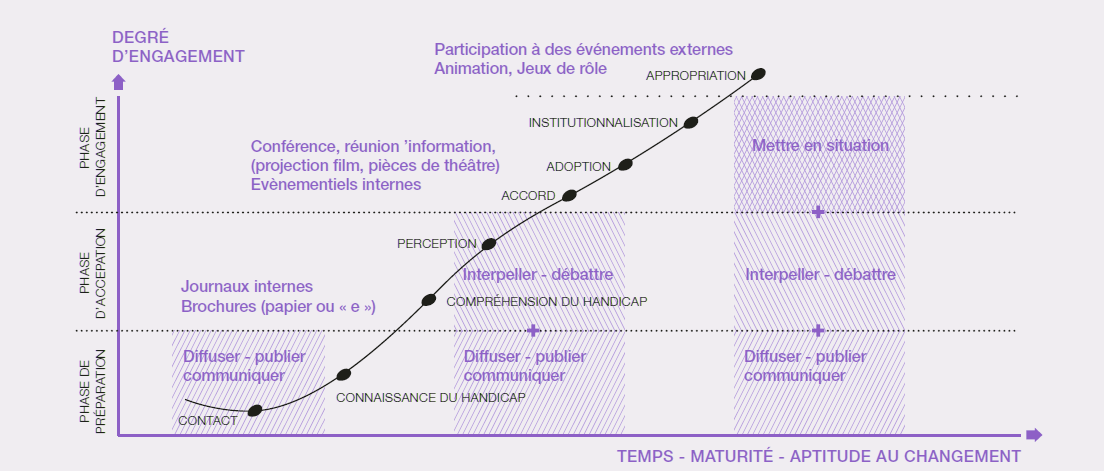How to Integrate Disability into Corporate Policy?

Tribune of Gwenaël Berthélemé-Saudreau
Ask an employer what he thinks about disability in business. There is a good chance that the intention is positive. There are many companies today that are committed to diversity policies. They are justifiably convinced of the validity of these approaches, both on the added value for the collective work and on the levers that they can constitute in their quest for performance. However, on closer inspection, the organizations are still struggling to turn this consensual speech into reality.
"
Question the company’s real social commitment
If the commitment is sometimes placed at the highest level of the company, the subject of disability is very widely carried in the company by human resources teams. They offer a response to particular needs. It is in this gap between practice and intentions that one observes the companies level of maturity on this subject. In the observation of companies that choose to engage in disability actions, internal and external practices can be distinguished.
Internally, many organizations offer awareness raising, training, and other communication devices to accompany their employees in the integration or retention of people with disabilities. If resources are mobilized, companies perceive that there still is a significant margin in progress to improve efficiency.
Externally, when the company turns toward its customer or supplier, initiatives are scarce. It is not obvious for the economic actor to think of its business model enriched by his/her commitment to disability. Yet people with disabilities can be in their needs and expectations, a relevant target for market development. Indeed, they share needs with other categories of populations, such as seniors, for instance. Considering them is therefore a means of paying particular attention to the characteristics of distributed products and services, measuring the limits of a supply that can evolve, or even segmenting otherwise standardized markets. On an external level, today, agreements with suppliers have been enhanced by new requirements for diversity, including disability. They are perceived as ‘guarantees’ of respectability but can also give a meaning to partnerships linked to the economic activity of the company.
Looking for consistency
The energy and budgets devoted to developing the affectio societatis of the company cannot in the current context emerge from the need for consistency between the discourse of commitment conveyed by the company and the feelings of its internal and external stakeholders. The coherence of the company’s commitment is assessed on four axes: the institutional discourse of the company, the organization that ensures its implementation in its practices, and the balance between initiatives that are both internal and external. The disability of an employee is a decorrelated characteristic of his skills, saying it is one thing, implementing it another. For example, in a consulting firm, daring to put in contact with the client his professionally competent consultants with a disability, means maintaining the consistency of a disability policy.

Overcoming stereotypes and raising awareness in the company
An internal sensitization to disability requires that appropriation times are thought in the first place to engage these actions in a sustainable movement. We need to get the teams to commit. Three phases can follow: preparation, acceptance and commitment. In each phase there are objectives and tools to be deployed. The actions carried out make it possible to engage employees gradually in an inevitably iterative movement, which varies according to the time, maturity and the targeted populations ability to change.
The objective of the preparation phase is to make employees available. The first contact with the subject precedes a knowledge input on disability. The preferred tools are internal newspapers, brochures, web releases, and so on, which make it possible to broadcast, to publish, to communicate. The co-worker starts with hearing about something and then knows what it is.
An acceptance phase can then be worked on, advancing employees’ understanding of disability and thus changing their perception of the subject and its issues. In order to challenge and debate, conferences, information meetings, internal events, movies or plays can be set up. Employees measure the consequences for them of these approaches in favor of disability, and the interest of getting involved. The commitment phase can finally be tackled by situating targeted populations, participating in external events, role plays and animations. They are led to adopt the postures of the company and the suggested practices. These can then be institutionalized. The employees take ownership of these new practices of the company, which go beyond them.
Awareness may experience times of failure. When devices are frightening, or distancing, sensitization is ineffective. When it is not followed in the practice of the company it is little necessary or unnecessary. Finally, it may even be risky if it does not tell the truth or if it uses stale language. On the other hand, a successful awareness raising allows the employees to understand, to adhere and to act. It then creates the conditions for the transformation of the responsible company.
The stereotypes around disability which have existed for many years are stubborn and companies are still young to assert themselves as actors in the integration of disability in the economic world. However, without employers, there will be no employment of employees with a disability. The company gains expertise and becomes every year a little more efficient and confident to push the subject and the practices, forward in accordance with its own constraints.
"

Gwenaël Berthélemé-Saudreau
Gwenaël Berthélemé-Saudreau works on CSR models since 2001 and collaborates with IMS on these topics. After directing and moderating the Entreprises & Handicap (Companies & Disabilities) Agency and its Ceo Club for 8 years, she now advises organisations on their HR development models in connection with working conditions (psychosocial risks, absenteeism, work/life balance and quality of life at work) and diversity (seniors, disabilities, gender).
To be read also in the dossier " Disability in the Workplace":


